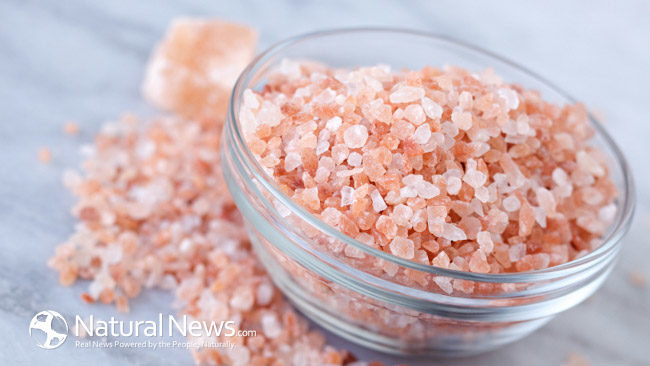Pink Himalayan salt is now officially considered to be the purest salt on earth, containing over 84 trace elements in their natural mineral form as well as being free from contaminants, pollution and any added chemicals.
It is hand-mined from the foothills of the Himalayas where it has been preserved under lava, snow and ice for 250 million years. It contains multiple health benefits, such as lowering blood pressure, reducing muscle cramps and improving digestion, as well as containing superior flavor and aesthetic appeal. It’s pink and red color signals its iron-rich content, which has been shown to boost red blood cell count and increase oxygenation throughout the body. This helps to boost cognitive function, rejuvenate cells and improves the strength of tissues and bones in the body.
Regular table salt, on the other hand, is quite the opposite and can be detrimental to your health. It is produced by exposing sea salt crystals to 1200 degrees Fahrenheit heat until all natural minerals are stripped and ground down, after which it is bleached and combined with iodine and anti-caking agents. In the 1920’s it was decided that in order to correct the population’s iodine deficiency, it had to be added to table salt as a supplement to prevent thyroid malfunction, goiter and cretinism. However, the 2% supplementation comes at the price of toxic chemicals and a substance unrecognizable to your body.
How Does the Body Respond to Himalayan Salt?
As soon as Himalayan salt is ingested it stimulates the salivary glands and essential digestive enzymes, which ensures proper digestion and a well-maintained pH balance in the stomach. This helps to reduce acid reflux and improves nutrient absorption, as well as improving the rate at which food is broken down.
The natural crystals are preserved in their true form, which makes Himalayan salt highly absorbable and easily recognized by your body. The incredible amount of minerals which includes calcium, magnesium, iron, and zinc helps to detoxify your body and strengthen immunity while rejuvenating every cell in your body. Himalayan salt is also highly alkalizing, which restores pH balance and increases cognitive function, energy and overall health.
The natural antibacterial and antimicrobial properties further help to destroy germs and harmful bacteria, which prevents colds and flu and heals infections faster. Himalayan sea salt has even been linked to decongesting sinuses and reducing asthma, which is why modern therapeutic centers often include a salt bath or salt inhalation therapy for better health.
The best part is, Himalayan sea salt contains absolutely no negative side effects. It’s 82% lower in sodium than table salt, which helps to reduce blood pressure and water retention, the opposite of what table salt does.
How Does the Body Respond to Table Salt?
Typical salt is made up of 98% sodium chloride and 2% of synthetic iodine, bleach and unnatural chemicals. The added anti-caking agent and preservatives are toxic and terrible for your health.
More than 90% of processed food contains in excess of the recommended daily amount of sodium, which is limited to 2000 milligrams per day according to the World Health Organization. This means that when you add more table salt to your food, you are getting dangerously close to developing high blood pressure, weight gain, edema and a complete imbalance in your body.
Table salt crystals are totally isolated from each other, taxing your body with enormous effort in metabolizing it efficiently. This causes a major disruption in fluid balance and can lead to chronic inflammation and multiple diseases and discomforts.
If your body cannot eliminate all of the sodium, it is forced to neutralize it by using 23 times the weight of salt in water. This water is taken from your living cells, which can cause dehydration, unsightly cellulite, rheumatism and kidney stones.
Additionally, each teaspoon of table salt contains 2325 milligrams of sodium, which exceeds the daily limitation by 16%. Surveys have shown that the average American gets anywhere from 6000 to 10 000 milligrams of sodium per day, which explains why as much as a third of the population suffers from hypertension.
When salt and anti-caking agents are added to a bowl of water it is evident that the anti-caking agent does not allow the salt to be dissolved. The same happens inside of the body, where excess salt gets deposited in organs and tissues and causing severe health problems over time.
How to Use Pink Himalayan Salt?
It’s as easy as replacing your dirty table salt habits with new pink salt! Use it in cooking, baking and dressings.
You can even add one teaspoon of Himalayan salt to a glass of water to relieve acid reflux/heartburn, which will also give you a boost in electrolytes and minerals.
Himalayan salt is also currently available to purchase in whole, large slabs which are becoming very popular in the kitchen! You can set it on top of the stove and let it gently warm and flavor meat, eggs and whatever else you want to cook and then a gentle wipe will do the trick to clean it for the next round! Make the switch today! Your body will thank you for it.
More Posts By Author Sophie Robinson.





